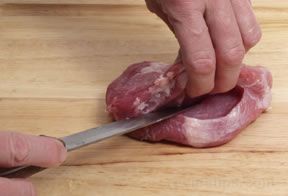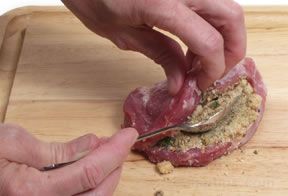|
Stuffing can be used in crown roasts, extra thick chops or steaks, rolled roasts or rolled into flattened tenderloin. The stuffing can be made from a simple bread base or a wild rice mixture, with ingredients such as onions, garlic, lemon, herbs, and spices added for extra flavor. A variety of other ingredients, such as sausage, vegetables, mushrooms, pecans, and chestnuts can be added to make up a more complex recipe with a unique flavor. It is common to use eggs for binding and stock or broth to moisten the stuffing.
When stuffing a crown roast, fill the center of the roast with the stuffing and then cover the stuffing with foil. Remove the foil during the last 45 minutes to an hour of the cooking time so that the stuffing can brown. To stuff extra thick chops or steaks make a slit along the side, through the middle of the chop to form pocket to hold the stuffing.
|

|
- To stuff extra thick chops or steaks make a slit along the side, through the middle of the chop to form pocket to hold the stuffing.
|
 |
- Stuff the chop lightly, being careful not to over stuff. Any remaining stuffing can be placed in a glass baking dish and baked separately.
|
Rolled roasts and flattened tenderloins that are stuffed generally have a layer of the stuffing spread over the meat and are then rolled up and tied before cooking. If the stuffing contains egg, it must be cooked until it reaches an internal temperature of 165°F to ensure that it is safe to eat.
The following guidelines should be followed in regard to stuffing:
- If using a recipe where the stuffing or any parts of it are cooked in any manner, it must be completely cooled before inserting into the meat.
- Do not overstuff because the stuffing will expand during cooking.
- Stuffing should reach an internal temperature of 165°F when eggs are one of the ingredients.
- Always thoroughly sanitize any utensils and areas exposed to the raw meat or juices.
- For stuffed chops, be sure to purchase chops that are at least 1 ¼ to 1 ½ inches thick.
| Note: NEVER stuff meat in advance. Stuffing in advance will increase the risk of bacteria growth. Stuffing can be made in advance and refrigerated separately from the meat and then inserted just before cooking. |
|

